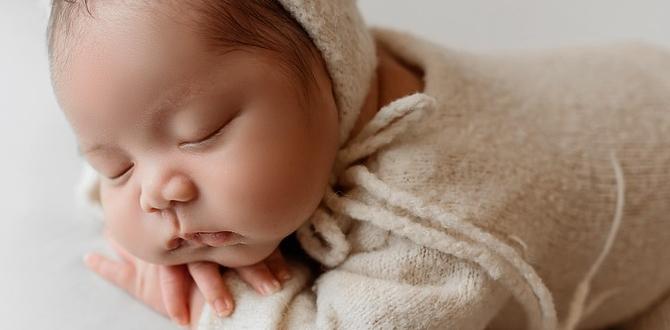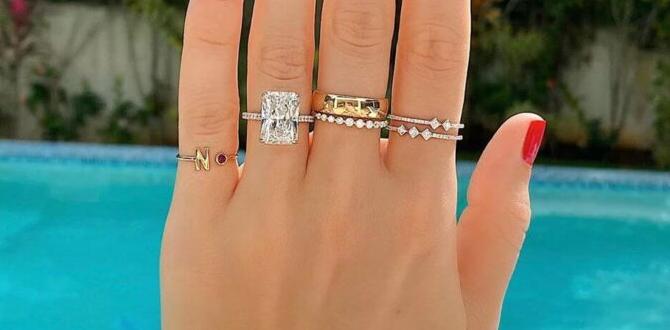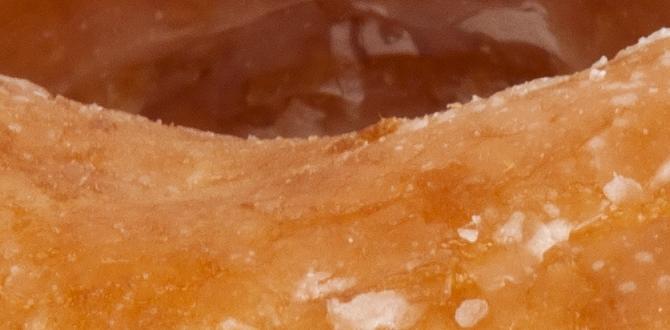Effortless beauty is at your fingertips! Discover simple hand-drawn nail design ideas perfect for beginners, transforming your nails with easy-to-follow steps and inspiring creativity for a stylish, personalized manicure.
Dreaming of beautiful, unique nails but feeling intimidated by complex nail art? You’re not alone! Many of us see stunning designs online and think, “I could never do that.” But guess what? You totally can! Creating gorgeous nail art doesn’t require a fine arts degree or a professional salon visit. With just a few simple tools and some easy-to-master techniques, you can bring beautiful, hand-drawn designs to life right on your nails. Get ready to unleash your inner artist and give your manicure a personalized, stylish touch that’s surprisingly simple. Let’s dive into the world of effortless nail art!
Unleash Your Inner Artist: The Magic of Simple Hand-Drawn Nail Designs
Who said nail art has to be complicated? At Nailerguy, I believe everyone can create beautiful and expressive nail designs. Hand-drawn nail art is all about channeling your creativity onto a tiny canvas – your nails! It’s a fantastic way to jazz up a basic manicure without needing special brushes or intricate skills. Think of it as doodling, but way more glamorous. These designs are perfect for adding a personal flair to your look, whether you’re heading to work, a special event, or just want to brighten your day. The best part? They are totally achievable, even if you’ve never picked up a nail art brush before.
Why Simple Hand-Drawn Designs Are Your New Best Friend
Let’s break down why embracing simple hand-drawn nail designs is such a brilliant idea for beginners and busy bees alike:
- Effortless Elegance: Even the most basic lines or dots can look incredibly chic and sophisticated.
- Accessible Tools: You likely already have most of what you need, or can get them easily and affordably.
- Boosts Confidence: Successfully creating art on your nails is incredibly rewarding and empowering!
- Endless Creativity: The possibilities are truly limitless, allowing for unique self-expression.
- Budget-Friendly: Say goodbye to expensive salon manicures; achieve salon-worthy looks at home.
- Quick & Easy: Many designs take just minutes to complete, fitting perfectly into a busy schedule.
Getting Started: Your Essential Hand-Drawn Nail Art Toolkit
Before we get our hands (and nails!) dirty, let’s make sure you have the right tools. Don’t worry, this isn’t an extensive, scary list. These are simple items that will make your nail art journey much smoother.
The Must-Haves for Beginner Nail Artists
- Base Coat: This protects your natural nails and helps polish adhere better. A good quality base coat is crucial for a long-lasting manicure. Check out recommendations from sources like the U.S. Food and Drug Administration (FDA) on nail products for insights into safe cosmetic ingredients.
- Top Coat: This seals your design, adds shine, and prevents chipping. A quick-dry top coat is a lifesaver!
- Nail Polish: Various colors! Start with a few basics: black, white, and a couple of your favorite shades.
- Fine-Tipped Nail Art Brush or Dotting Tool: These are your primary drawing instruments. You can find excellent, affordable sets online or at beauty supply stores. A regular toothpick can also work in a pinch for dots!
- Nail Polish Remover: For those “oops” moments and cleaning up edges. Cotton pads or lint-free wipes are helpful here.
- Orange Stick or Cuticle Pusher: For cleaning up polish around your cuticles.
Optional, But Helpful Additions
- Gel Polish & UV/LED Lamp: For a longer-lasting, chip-resistant finish.
- Stencils or Stickers: Can be used as guides for hand-drawn elements.
- Thin Nail Art Pens: Offer a different kind of control for drawing lines.
- Clean-Up Brush: A small, stiff-bristled brush (like an old, clean makeup brush) dipped in remover for precise clean-up.
Simple Hand-Drawn Nail Design Ideas: Step-by-Step Guides
Now for the fun part! Let’s get creative with some super simple, yet stylish, hand-drawn nail design ideas. We’ll cover everything from basic dots to elegant lines. Remember, practice makes perfect, and it’s okay to make mistakes – that’s what nail polish remover is for!
1. The Classic Polka Dot Manicure
Polka dots are timeless, cute, and unbelievably easy to create. They add a playful pop to any color scheme.
Tools Needed:
- Your favorite nail polish (base color)
- A contrasting color for the dots
- A dotting tool, toothpick, or the tip of a bobby pin
Steps:
- Prepare Your Nails: Start with clean, dry nails. Apply a base coat and let it dry completely.
- Apply Base Color: Paint your nails with your chosen base color. Apply two coats for full opacity and let them dry thoroughly. Rushing this step is a common mistake!
- Create the Dots: Dip your dotting tool (or toothpick) into the contrasting polish. Gently dab the tip onto your nail to create a dot. Don’t press too hard!
- Place Your Dots: Start by placing a few dots. You can make them all the same size, or vary them for a more dynamic look. You can create random patterns or arrange them in neat rows.
- Clean Up & Seal: Once your dots are dry, carefully clean up any polish you may have gotten on your skin using a cotton swab dipped in nail polish remover.
- Apply Top Coat: Swipe on a layer of top coat to seal your design and add shine.
Variations:
- Uneven Dots: Use different sized dotting tools or vary the pressure to create dots of different sizes.
- Color Blocking Dots: Use two or three different colors for your dots.
- Accent Nail Dots: Apply dots to just one or two nails for a subtle touch.
2. Elegant Lines & Stripes
Lines can be incredibly chic and modern. With a steady hand, you can create anything from thin pin-stripes to bold geometric patterns.
Tools Needed:
- Your favorite nail polish (base color)
- A contrasting color for the lines
- A long, thin nail art brush or striping tape (optional, for cleaner lines)
- A steady surface to rest your hand on
Steps:
- Prep and Base Coat: Apply your base coat and let it dry. Then, apply your base color in two thin coats, allowing each to dry completely.
- Option A (Freehand Lines):
- Dip your fine-tipped brush into the contrasting polish. Wipe off excess on the edge of the bottle.
- Rest your pinky finger on your work surface for stability.
- Gently draw your line from one side of the nail to the other. Start with thinner lines; thicker ones are easier to control.
- Try vertical, horizontal, or diagonal lines.
- Option B (Striping Tape):
- Adhere striping tape to your fully dried base color. Press down the edges firmly to prevent polish from bleeding underneath.
- Paint over the tape with your contrasting color.
- While the new polish is still slightly wet (but not goopy), carefully peel off the striping tape. This will leave a crisp, clean line.
- Clean Up & Seal: Clean up any stray marks with a remover-dipped cotton swab. Finish with a top coat.
Variations:
- Chevron Lines: Draw two diagonal lines meeting in the center.
- Checkerboard: Create a grid of intersecting lines.
- Thin French Tips: Instead of a wide sweep, use a thin brush to draw a fine line across the tip of the nail.
3. Minimalist Dots & Doodles
Keep it simple with abstract patterns. Think small details that pack a stylish punch. This is where personalization really shines!
Tools Needed:
- Your favorite nail polish (base color)
- A contrasting color (or two) for the details
- Fine-tipped nail art brush, toothpick, or even the edge of a thin eyeshadow applicator
Steps:
- Foundation First: Apply base coat and your chosen base color. Let it dry completely.
- Get Doodling:
- Tiny Hearts: Use a dotting tool to make two small dots close together, then use your brush to connect them slightly at the top to form a heart shape.
- Sparkles/Stars: Draw small ‘X’ shapes or asterisk-like shapes with your brush.
- Abstract Swirls: Create simple, curved lines or small, abstract shapes.
- Mini Dots: Place a few very small dots strategically on the nail for a constellation effect.
- Refine and Finish: Clean up edges and apply a protective top coat.
For inspiration on simple doodle designs, you can look at abstract art or even simple nature elements like tiny leaves or flowers. Remember, the goal is simplicity and charm!
4. The “Easy Gradient” (Or Ombre Effect)
While a true ombre can be tricky, a very simplified version is achievable with basic tools. This gives a subtle color transition that looks super chic.
Tools Needed:
- Two (or three) coordinating nail polish colors
- A makeup sponge (a standard makeup sponge or even a clean kitchen sponge cut into a small piece)
- Base coat and top coat
- Nail polish remover and cotton swabs/brush for cleanup
Steps:
- Prep Nails: Apply base coat and let it dry. Apply your lightest color as the base and let it dry completely.
- Prepare the Sponge: Using a piece of makeup sponge, paint thin stripes of your colors next to each other. For a simple two-color gradient, paint one stripe of your lighter color and one stripe of your darker color.
- Dab and Blend: Gently dab the sponge onto your nail. You’ll want to dab just the colored part of the sponge onto the nail.
- Build the Color: You may need to reapply polish to the sponge and dab again to build up the color intensity. Try dabbing the sponge lightly side-to-side on the nail to help blend the colors.
- Clean Up: This can get messy! Use your makeup brush or cotton swab dipped in nail polish remover to clean up the polish around your cuticles and sidewalls.
- Seal the Deal: Apply a generous layer of top coat. This will help smooth out any texture from the sponge apply.
This method creates a more textured, less precise gradient than traditional ombre techniques, but it’s incredibly easy and looks lovely.
5. Subtle Accent Nail Art
Don’t feel pressured to do complex art on every nail. Focusing on one accent nail can be very effective and is a great way to practice without commitment.
Tools Needed:
- Your staple nail art tools (brushes, dotting tools, etc.)
- Your chosen color scheme
Steps:
- Paint the Rest: Paint all your nails except one with a solid color. Let them dry completely.
- Design Your Accent: On your chosen accent nail, apply your base color and then add your chosen simple design. This could be a few dots, a single line, a tiny heart, or a simple stripe.
- Coordinate and Seal: Ensure your accent nail complements your other nails. Finish all nails with a top coat.
This is perfect for when you want a hint of nail art without it being overpowering. It’s a sophisticated look that’s incredibly easy to achieve.
Tips for Flawless Hand-Drawn Nail Art
Even the simplest designs can be elevated with a few pro tricks. Here are some tips to help you achieve a more polished finish:
- Work on Clean, Dry Nails: Always start with a clean canvas. Ensure your base color is fully dry before adding any details. This prevents smudging and lifting.
- Less is More with Polish: When loading your brush or dotting tool, don’t use too much polish. A small bead is usually enough. Too much polish can lead to blobs and smudges.
- Steady Your Hand: Rest your wrists and elbows on a stable surface. You can even rest your pinky finger on the table for extra support while drawing lines.
- Clean Up as You Go: Don’t wait until the end to clean up mistakes. Dip a fine-tipped brush or cotton swab in nail polish remover and gently swipe away any polish that got on your skin or cuticle.
- Cap Your Free Edge: When applying your base color and top coat, swipe a little bit of polish along the very edge (tip) of your nail. This helps prevent chipping and “seals” the design.
- Patience is Key: Allow each layer to dry sufficiently before applying the next. Rushing is the enemy of good nail art!
- Practice on Paper: If you’re nervous, try drawing your designs on a piece of paper with nail polish first. This helps you get a feel for the brush and the polish flow.
Troubleshooting Common Nail Art Mishaps
We’ve all been there! Don’t let a little mistake get you down. Here’s how to fix common issues:
| Problem | Solution |
|---|---|
| Smudged Design | If it’s still wet, gently try to smooth it with a clean brush or toothpick. If it’s very smudged, you might need to remove that nail and start again. For minor smudges, a small amount of polish remover on a fine brush can sometimes help redefine the edge. |
| Polish is Too Thick/Thin | Thick polish can be hard to control and may clump. Try adding a drop of nail polish thinner (not remover!) to your bottle. Thin polish can be streaky; apply more layers and ensure each dries. |
| Uneven Lines/Dots | Don’t aim for perfection! Embrace the slightly imperfect look for a charming, hand-drawn feel. For cleaner lines, try striping tape or allow your base color to dry fully. For dots, practice consistent pressure. |
| Polish Bleeding Under Tape | Ensure your base color is completely dry before applying tape. Press down the edges of the tape firmly. Peel the tape off when the top polish is still slightly wet (but not runny). |
| Too Much Polish on Brush | Always wipe excess polish on the bottle rim. A small amount is easier to control and results in a cleaner finish. |
Beyond the Basics: Taking Your Designs Further
Once you’re comfortable with dots and lines, you can explore adding a little more complexity. Don’t be intimidated! Start small and build your confidence.
Ideas to Inspire Your Next Design
- Floral Accents: Draw tiny, simple flowers. A few dots for the center and some small petals can look lovely.
- Geometric Glitz: Combine lines and shapes to create more intricate patterns. Think triangles, squares, and overlapping forms.
- Abstract Swirls & Waves: Play with curved lines to create a fluid, artistic effect.
- Negative Space Designs: Leave parts of your nail bare (no polish) and draw designs around them. This looks very modern and chic.
- Textured Finishes: Pair your hand-drawn designs with textured polishes like matte, glitter, or chrome for added dimension.
Remember, the goal is to have fun and express yourself. Your nails are a unique part of your style, so let them shine!
Frequently Asked Questions About Simple Hand-Drawn Nail Designs
Q1: What is the easiest nail art for beginners?
The easiest nail art for beginners is typically polka dots. They require minimal precision and can be done with a simple dotting tool or even a toothpick.





